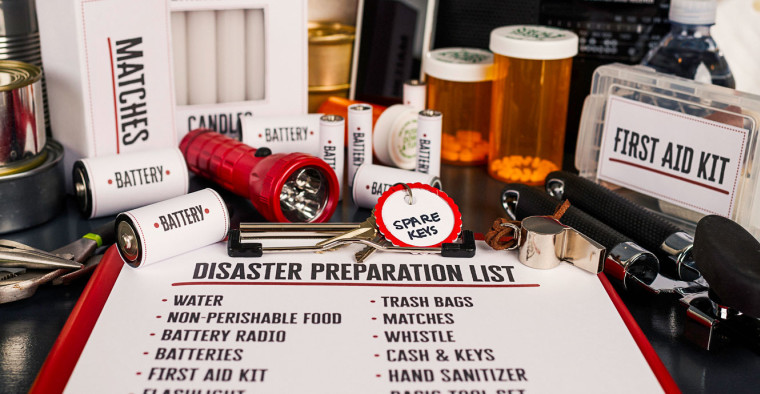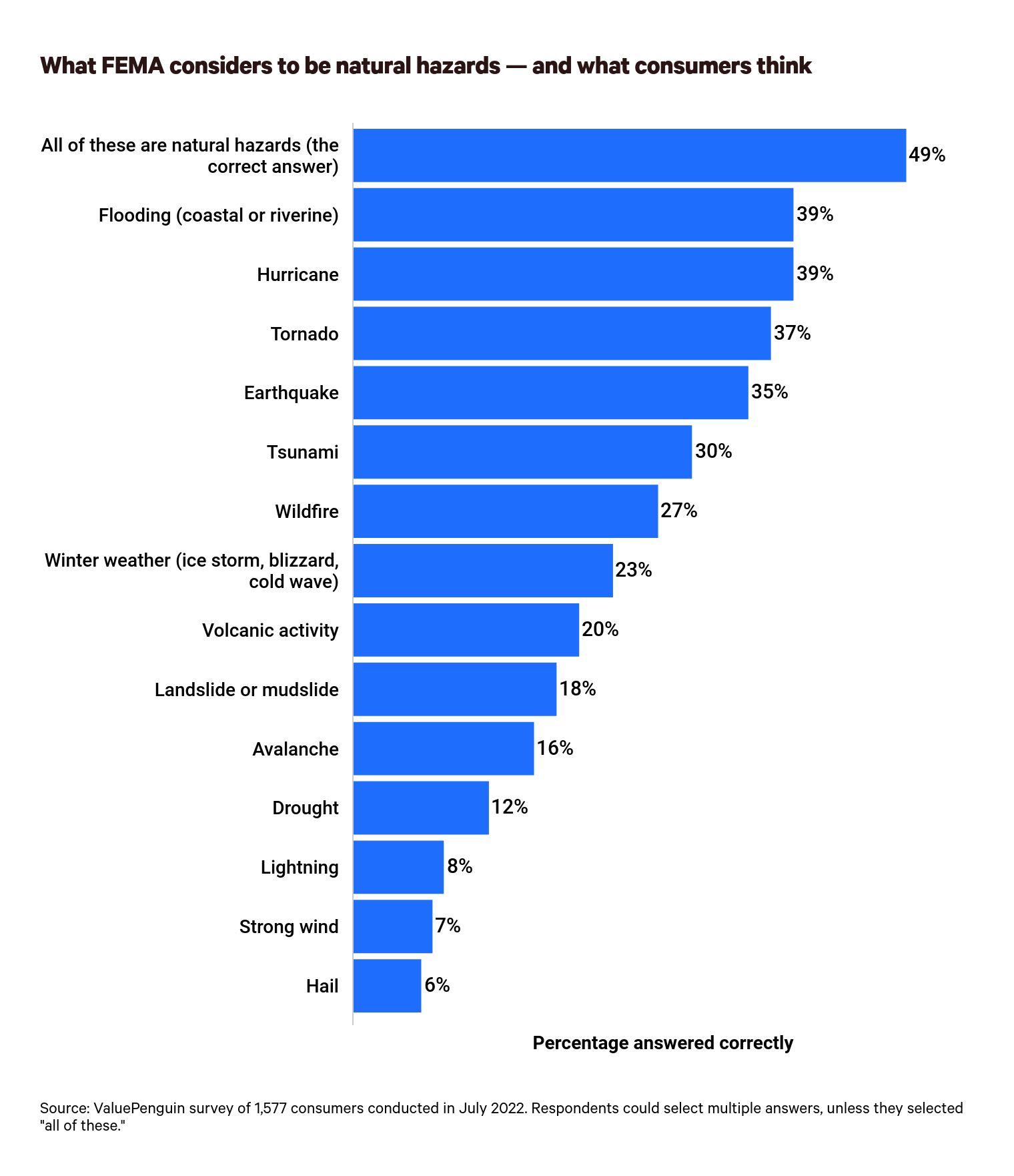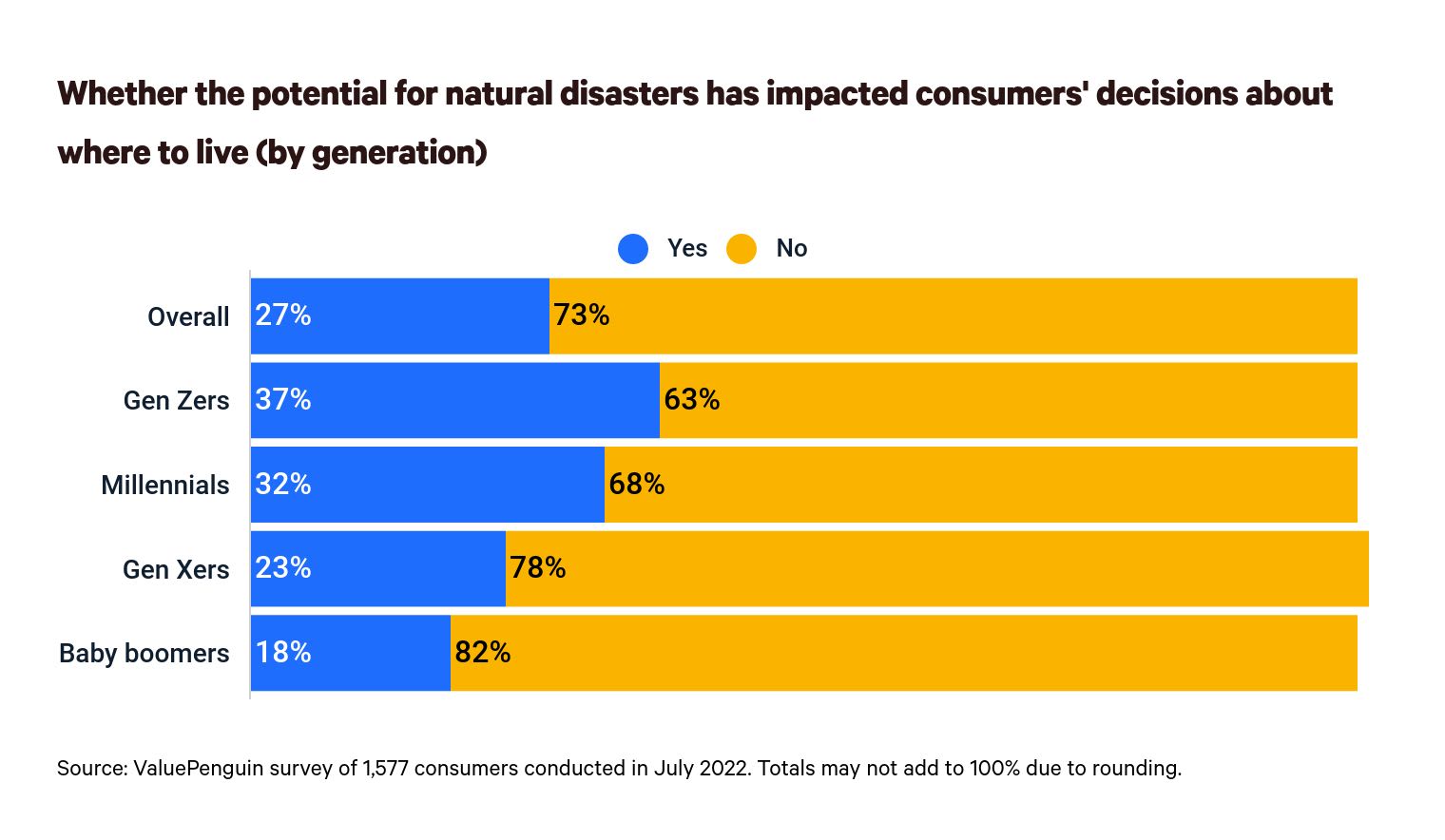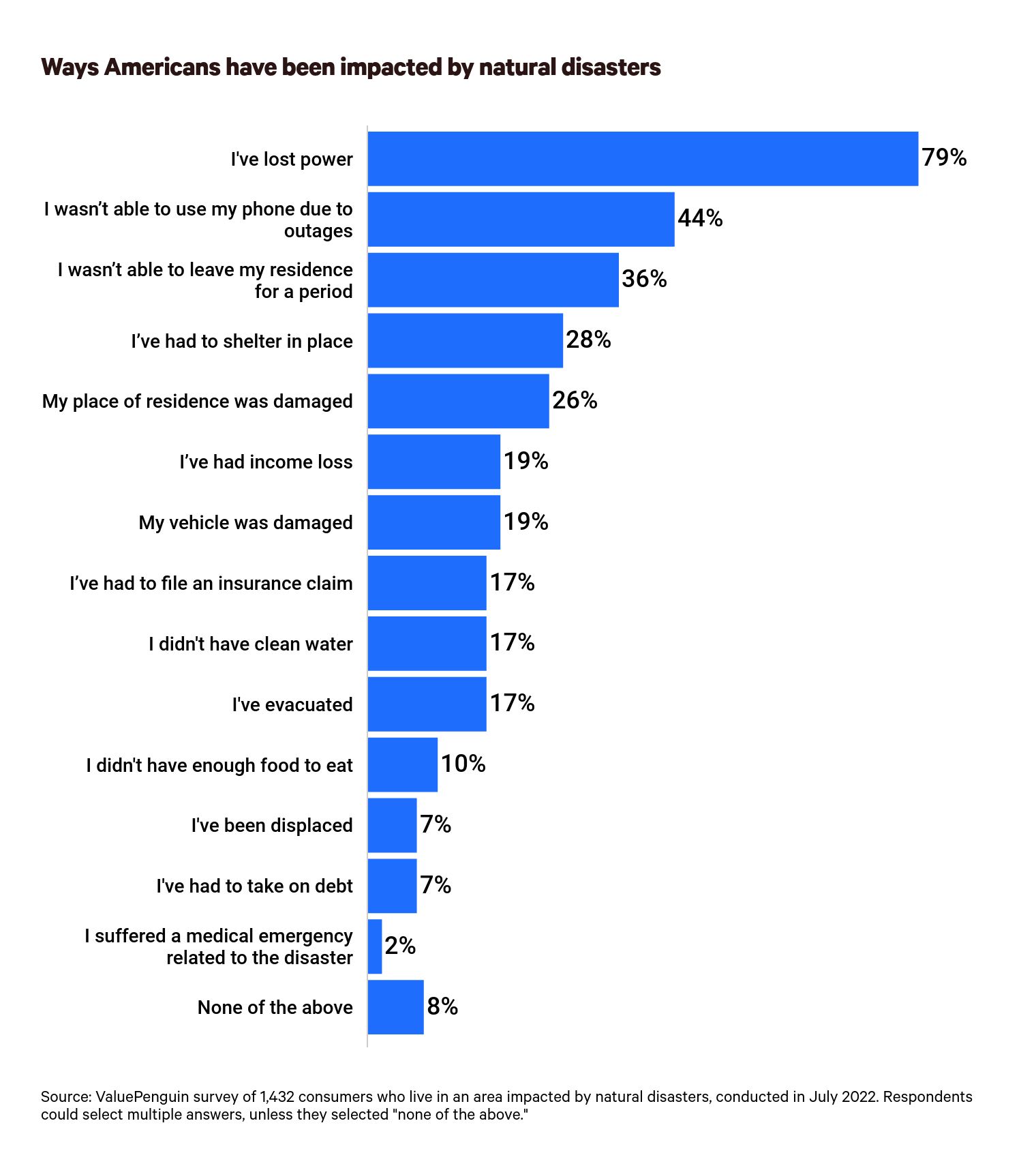Homeowners Insurance
66% of Americans Don’t Feel Fully Prepared for Natural Disasters, and 45% Don’t Know if Their Insurance Covers Related Claims

Despite another record-breaking summer of brutal heat waves and wide-scale flooding, the majority of Americans say they don’t feel entirely prepared for a natural disaster. In fact, almost half of consumers don’t know what disaster damages their homeowners insurance policy includes — which may leave some with inadequate coverage.
We asked nearly 1,600 U.S. consumers about their natural disaster preparedness. In addition to discussing what Americans are missing in their emergency preparedness kits, we’ll also go over the percentage of consumers who consider their potential exposure to a disaster when deciding where to live. Finally, we’ll discuss the implications of living in a high-risk area on homeowners insurance policies.
On this page
- Key findings
- Most Americans don’t feel fully prepared for natural disasters
- 45% don’t know what disaster damages their homeowners insurance covers
- What does FEMA consider to be a natural hazard? Majority of Americans don’t know
- Likelihood of experiencing a natural disaster impacts where young consumers choose to live
- Nearly all Americans living in disaster-prone areas have been impacted
- Preventing financial losses from natural disasters: Top tips for homeowners
- Methodology
Key findings
- Two-thirds of Americans don’t feel fully prepared for potential natural disasters, with many lacking key emergency preparedness items. The main things consumers don’t have include generators (73%), emergency evacuation kits (68%) and radios (45%). Overall, Southerners feel most prepared, while Westerners feel least prepared.
- 45% of Americans don’t know what their insurance covers related to natural disaster claims. And only 26% say they have an additional natural disaster insurance policy.
- The Federal Emergency Management Agency (FEMA) classification of natural disasters is critical in determining aid, but most consumers aren’t sure what could be considered a natural hazard. In total, 51% of Americans couldn’t name all 18 events that FEMA considers natural hazards, which is a vital first step in classifying natural disasters. Specifically, less than 10% of consumers know hail, strong wind and lightning can be considered natural disasters.
- A significant percentage of Gen Zers (37%) and millennials (32%) are factoring natural disasters into decisions about where to live. That’s compared with 23% of Gen Xers and 18% of baby boomers.
- More than a third of Americans (36%) believe natural disasters are getting more frequent and powerful. This belief is most common among baby boomers (43%).
Most Americans don’t feel fully prepared for natural disasters
In total, two-thirds of Americans don’t feel fully prepared for potential natural disasters, but that figure varies by region. Southerners (37%) are the most likely to feel fully prepared, while Northeasterners are the most likely to feel somewhat prepared (59%). Westerners, on the other hand, feel the least prepared. Here’s a full breakdown:
- Southerners: 37% feel fully prepared and 53% feel somewhat prepared
- Northeasterners: 32% feel fully prepared and 59% feel somewhat prepared
- Midwesterners: 34% feel fully prepared and 56% feel somewhat prepared
- Westerners: 27% feel fully prepared and 56% feel somewhat prepared
One reason why consumers don’t feel prepared? It may be because many lack key emergency preparedness items. Notably, 68% of Americans don’t have an emergency evacuation kit — making it the least prevalent preparedness item behind generators (73%). For a closer look at what supplies consumers do have, take a look at the graph below:

FEMA recommends including a radio in a basic emergency supply kit to receive critical emergency weather updates or evacuation information during a disaster, particularly because they’re built to withstand power outages or service failures while other devices (like cellphones) may fail. However, less than half (45%) of Americans have one. Additionally, 37% don’t have at least three days worth of water and 25% don’t have three days worth of nonperishable food set aside for an emergency.
Overall, just over a quarter (26%) have spent money in the past year to prepare for future natural disasters. Of this group, 9% have spent $10,000 or more, with men (12%) more likely to do so than women (5%).
Regardless of whether they feel ready, the majority of Americans (48%) will only start making preparations when they’re given advanced warning for an expected disaster. Meanwhile, 30% of Americans either don’t prepare for a natural disaster or only start preparing one day or less before a disaster is expected to hit.
45% don’t know what disaster damages their homeowners insurance covers
Insurance can be critical in preventing financial losses after a natural disaster, particularly with home damage. However, 45% of Americans don’t know what natural disaster claims their homeowners insurance covers — which may leave them with unexpected out-of-pocket expenses.

While damage caused by wind, hail and fire (which include wildfires and tornadoes) are generally covered by a standard homeowners insurance policy, losses caused by flooding or earth movement — such as earthquakes or landslides — aren’t typically covered. Still, damages that fall under a standard policy aren’t guaranteed. Poor home maintenance, like burst pipes or clogged gutters, may prevent homeowners from receiving an insurance claim.
Knowing what their policy covers can be critical for homeowners, particularly as over a quarter (26%) of Americans have made home improvements due to natural disaster damage. The highest percentage of these consumers (10%) have made exterior improvements, while 7% have made interior improvements. Meanwhile, 9% have made improvements to both. Separately, 14% say they plan to make home improvements.
Regardless of the percentage of homeowners who’ve had to make home improvements, only 26% of Americans have an add-on insurance policy for natural disasters. Of this group, 11% only have extra coverage because it’s required in their area, which is common in regions with a higher risk of flooding.
ValuePenguin home insurance expert Nick VinZant says he’s surprised by the low percentage of Americans who voluntarily purchase extra coverage, particularly as many homeowners are increasingly at risk of experiencing a natural disaster.
"A lot of people may not get additional coverage for natural disasters because it seems like something that won’t happen to them," VinZant says. "Unfortunately, natural disasters do happen, and they’re happening a lot more frequently. It’s a good idea to explore what options are available, particularly if you live in an area prone to disasters that aren’t covered by a standard policy."
Those who have additional coverage aren’t shelling out for it, either. In fact, most (41%) pay less than $500 in extra annual fees. Following that:
- 35% pay $500 to $1,500
- 18% pay $1,501 to $2,500
- 5% pay $2,501 to $3,500
- 1% pay more than $3,500
What does FEMA consider to be a natural hazard? Majority of Americans don’t know
That’s not the extent of Americans’ lack of knowledge, either. Just over half (51%) of Americans can’t identify all 18 natural hazards that FEMA considers in its National Risk Index, which is a critical tool used to determine nationally managed insurance coverage rates based on a property’s risk of experiencing a natural disaster. Specifically, less than 10% of consumers know hail, strong wind and lightning are natural hazards.

Natural hazards are distinct from natural disasters, but they also serve as a critical first step in classifying natural disasters. While FEMA defines a natural hazard as the threat of an event that’ll likely have a negative impact on a community, a natural disaster is the harm a hazard has on a community. FEMA’s natural disaster classification is what qualifies consumers for aid. Without it (and insurance coverage), consumers have to pay for disaster damages out of pocket.
Likelihood of experiencing a natural disaster impacts where young consumers choose to live
Although most consumers don’t have an in-depth understanding of natural disasters (and how they impact insurance rates), disasters still influence some consumers’ major life decisions. In total, 27% of consumers say they consider their potential risk of experiencing a natural disaster when deciding where to live, with Gen Zers ages 18 to 25 (37%) and millennials ages 26 to 41 (32%) the most likely to do so.

Americans aren’t confident in their state’s ability to handle a natural disaster, though. Despite almost three-quarters of Americans not factoring in their potential exposure to disasters when making homeownership decisions, the majority (54%) of Americans believe their state is only somewhat prepared for a natural disaster. Baby boomers ages 57 to 76 are the most confident in their state’s preparedness, with 92% believing their state is at least somewhat prepared. Meanwhile, just 84% of Gen Zers, millennials and Gen Xers ages 42 to 56 believe similarly. However, Gen Zers are the least likely to have confidence in their state, with just 27% believing their state is fully prepared for a disaster.
Young Americans’ concerns are warranted. Weather damages are getting more costly. A recent ValuePenguin study on weather-related property damages found that severe weather caused $121.4 billion in damages between 2017 and 2021. Of these, just over three-quarters (75.8%) were covered by insurance — leaving an estimated $29.4 billion in damages not covered.
Additionally, as natural disasters increase in frequency, more U.S. properties are at risk of weather-related damages. Floods, which are a particular concern for property owners, are a good example. Anywhere between 8.4 million and 16.5 million properties are at risk of flooding, according to another ValuePenguin study on flood risk.
Consequently, insurance rates are increasing. A ValuePenguin study on rising flood insurance rates found that around 77% of homeowners have seen an increase in insurance premium costs under FEMA’s Risk Rating 2.0, a new flood insurance rating procedure that went into effect in October 2021.
Nearly all Americans living in disaster-prone areas have been impacted
Overall, 91% of Americans say they’ve experienced a natural disaster. Of the 91% of Americans living in an area with increased risk, nearly all (92%) have been negatively impacted by natural disasters. Power outages (79%) are the most common impact, but among those who’ve been impacted financially:
- 26% have experienced damage to their place of residence
- 19% have lost income
- 19% have experienced damage to their vehicles
- 17% have been evacuated
Gen Xers (26%) and Southerners (23%) are more likely to report income loss. Southern states have higher poverty rates than other regions, which may offer an explanation here. Households with low income are typically more impacted by natural disasters than their high-earning counterparts (more on that soon). They also tie with Westerners — where poverty rates are comparatively lower — as the most likely group to be evacuated (20%), which likely impacts income loss.
Additionally, Midwesterners — who are generally more prone to experiencing strong winds, tornados and hail than residents in other states — are the most likely to report home damage (31%) and car damage (26%).
By income group, just 12% of six-figure earners have lost income due to a natural disaster. That compares with 27% of those with household incomes between $35,000 and $49,999 — the most likely group to report income loss. Although six-figure earners were generally less likely to be financially impacted by a natural disaster than Americans at lower income levels, they were notably most likely to experience home damage (32%) and car damage (24%).
In light of these findings, it’s worth noting that research indicates natural disasters impact households with low income disproportionately. An NPR analysis of FEMA aid registrations between 2014 and 2018 found that the homeowners with the lowest income who’ve experienced natural disasters receive about half as much to rebuild their homes compared with higher-income homeowners. Additionally, FEMA was twice as likely to deny housing assistance to lower-income disaster survivors.

Are natural disasters getting worse? Here’s what Americans think
More than a third of Americans (36%) believe natural disasters are getting more frequent and powerful. Notably, baby boomers (43%) are the most likely to hold this belief.
Research has long indicated that natural disasters are increasing in frequency and severity, despite the relatively low percentage of Americans who believe so. What’s more, it’s already impacting Americans financially. According to the National Oceanic and Atmospheric Administration (NOAA), there were 22 weather and climate disaster events across the U.S. in 2020 alone in which total losses each exceeded $1 billion. The previous record for billion-dollar disasters in a year, which was set in 2011 and met in 2017, was 16.
Preventing financial losses from natural disasters: Top tips for homeowners
Though some properties are at more risk of experiencing a natural disaster than others, the increasing volatility of natural disasters means homeowners should have some preventive measures in place. To help mitigate the potential financial losses you may experience, VinZant offers the following advice:
- Decide which homeowners policy is right for you. VinZant recommends getting quotes from at least five companies to ensure you get your best insurance price. When deciding what policies meet your needs, make sure to factor in the size of your home, your property’s risk rating score and the value of your items.
- Preparation is key. "Make sure you have the right insurance policy first, then copy and secure your important documents," VinZant says. "Take a video of the things inside your home to ensure you receive proper coverage if your property gets damaged." Additionally, understanding the difference between the cash value of your items and replacement costs can play a critical role in ensuring your claims are approved if there’s an emergency.
- Make an emergency disaster kit using FEMA’s basic disaster supply kit list. Regardless of your area’s risk rating, FEMA advises that Americans have an emergency disaster kit. If you’re on a strict budget, consider building your emergency disaster kit over time. Preparing an evacuation kit, which should include important documents detailing your identification, bank records and prescription medications, can also ensure you don’t lose or forget crucial supplies in an emergency.
Methodology
ValuePenguin commissioned Qualtrics to conduct an online survey of 1,577 U.S. consumers ages 18 to 76 from July 26-29, 2022. The survey was administered using a nonprobability-based sample, and quotas were used to ensure the sample base represented the overall population. All responses were reviewed by researchers for quality control.
We defined generations as the following ages in 2022:
- Generation Z: 18 to 25
- Millennial: 26 to 41
- Generation X: 42 to 56
- Baby boomer: 57 to 76
